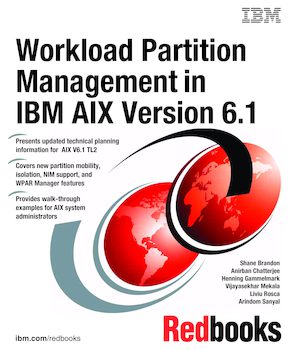Workload Partition Management in IBM AIX Version 6.1
An IBM Redbooks publication
Note: This is publication is now archived. For reference only.

Published on 24 December 2008, updated 29 December 2008
ISBN-10: 0738432075
ISBN-13: 9780738432076
IBM Form #: SG24-7656-00
Authors: Chris Almond, Shane Brandon, Anirban Chatterjee, Henning Gammelmark, Vijayasekhar Mekala, Liviu Rosca and Arindom Sanyal
Workload partition functionality, originally introduced in 2007 with the release of IBM AIX Version 6, is a strategic component of the IBM AIX Operating System. With the release of AIX V6.1 TL2 in November 2008, both the core functionality and features related to managing workload partitions have been improved and expanded.
This IBM Redbooks publication provides an updated introduction and “how to” guide for system administrators and architects using workload partitions in AIX V6.1 TL2. It builds on the original concepts and practices described in the first Redbooks publication about this topic, Introduction to Workload Partition Management in IBM AIX Version 6.1, SG24-7431 , published in 2007.
In AIX 6.2 TL2, significant enhancements to core workload partition functions and new features have been added. Some of the important feature updates provide more flexibility and support for enhanced mobility, improved isolation, and NIM integration. A new and significantly updated version of IBM Workload Partitions Manager for AIX (WPAR Manager), the Web browser-based graphical user interface for managing and monitoring WPARs, is also available. WPAR Manager is a platform management solution that provides a centralized point of control for managing WPARs across a collection of managed systems running AIX.
Part 1. Introduction
Chapter 1. Introduction to AIX workload partitions
Chapter 2. Understanding and planning for workload partitions
Part 2. Managing workload partitions
Chapter 3. Functional overview of workload partitions
Chapter 4. Overview of workload partition operations
Chapter 5. Managing workload partitions
Part 3. Advanced topics
Chapter 6. Security in workload partition environments
Chapter 7. Advanced configuration features
Chapter 8. Resource control
Chapter 9. Tracing and logging
Chapter 10. Developer considerations